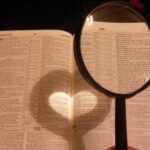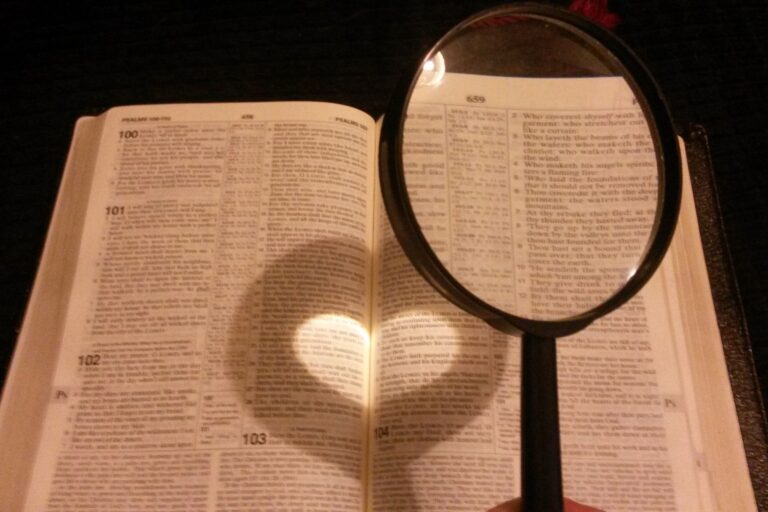I recently gave a talk at a Spiritual Growth summit entitled “The Bible’s Untold Connections: A Journey into Deeper Study.” There, I was only able to cover only two of the four topics that I will cover here for you.
Two topics is not enough! I consider this method of dimensional Bible reading to be of such foundational importance that I want everyone everywhere to know how to use it!
This is a long post with a lot of detail. Grab a cup of coffee/tea and get settled in and ready to take some notes.
Obligatory legal stuff before we get started: purelyjubilant.com is a user supported site (and in-person ministry). Our time writing and creating content for you is partially supported through the use of affiliate marketing. This means that if you choose to purchase products through our supplied links we may earn a percentage of the cost of the item that would instead go directly to the seller. This lowers the seller's profit, but does not directly change the price for you, the buyer. For more information, please see the "Disclosures, Disclaimers, Terms & Conditions' section near the bottom of this page. Now on to the good stuff!
the fight

“And Jacob was left alone; and there wrestled a man with him until the breaking of the day.
Genesis 32:24-30
And when he saw that he prevailed not against him, he touched the hollow of his thigh; and the hollow of Jacob’s thigh was out of joint, as he wrestled with him.
And he said, Let me go, for the day breaketh. And he said, I will not let thee go, except thou bless me.
And he said unto him, What is thy name? And he said, Jacob.
And he said, Thy name shall be called no more Jacob, but Israel: for as a prince hast thou power with God and with men, and hast prevailed.
And Jacob asked him, and said, Tell me, I pray thee, thy name. And he said, Wherefore is it that thou dost ask after my name? And he blessed him there.
And Jacob called the name of the place Peniel: for I have seen God face to face.
Would you like to see God face to face?
“In the beginning was the Word, and the Word was with God, and the Word was God.”
John 1:1
If you want to see more of God, spend more time in His Word!
For this cause I bow my knees unto the Father of our Lord Jesus Christ,
Ephesians 3:14-21
Of whom the whole family in heaven and earth is named,
That he would grant you, according to the riches of his glory, to be strengthened with might by his Spirit in the inner man;
That Christ may dwell in your hearts by faith; that ye, being rooted and grounded in love,
May be able to comprehend with all saints what is the breadth, and length, and depth, and height;
And to know the love of Christ, which passeth knowledge, that ye might be filled with all the fulness of God.
Now unto him that is able to do exceeding abundantly above all that we ask or think, according to the power that worketh in us,
Unto him be glory in the church by Christ Jesus throughout all ages, world without end. Amen.
Would you like to be strengthened with might by The Spirit of God? Doesn’t it sound great to be filled with all the fullness of God? These things aren’t just theoretical, we can have this in our own lives and it really isn’t as hard to attain as you might think that it is. Although we need the help of The Holy Spirit, we can grow in all of these things by spending time in God’s Word. I encourage you to take a fresh look at your Bible and your approach to it today!
Dimensional Bible Reading
As inspired by the Ephesians 3 prayer (see above), we can take a cue from the words breadth, length, depth, and height and use a four-pronged approach to strengthen ourselves through God’s Word.
Let’s start by increasing the breadth of what we study.
The Breadth of Dimensional Bible Reading
Man shall not live by bread alone, but by every word1 that proceedeth out of the mouth of God.
Matthew 4:4
If we live by the words that proceed out of God’s mouth, why aren’t we “eating” more of them?
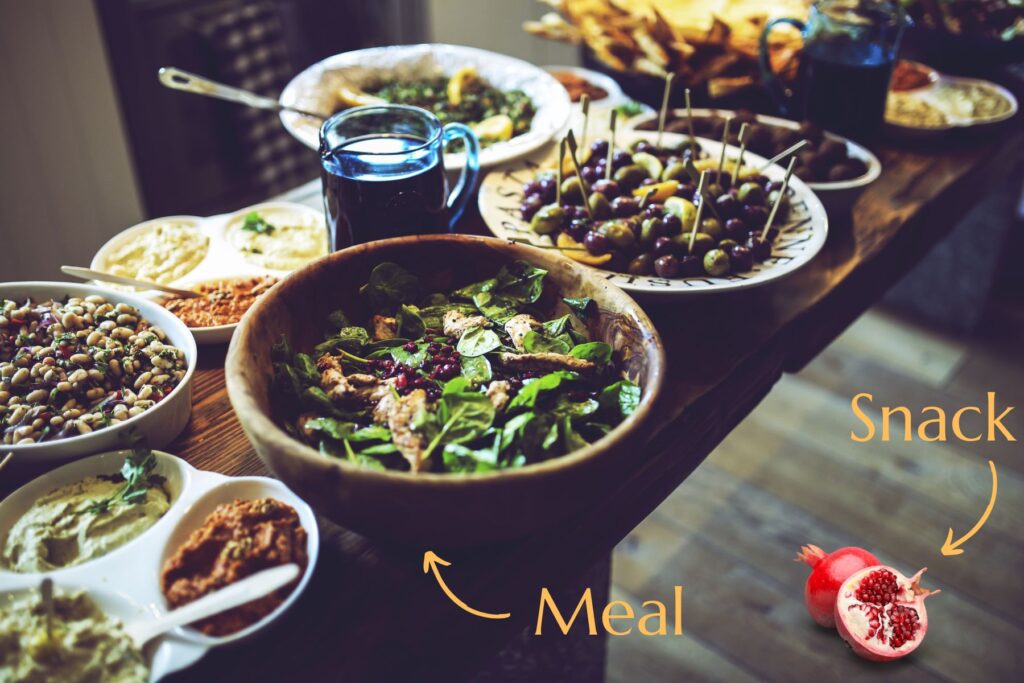
Are You Starving?
Many Christians/Christ-followers have themselves on starvation rations of God’s Word: only about 16% of Americans read their Bible most days of the week.2 In other words, if we don’t live by bread but by God’s Word, the majority of American Christians are withering away. We need to change that. There is a place for a bite-sized devotional with a verse or two to accompany it and there is a place even for a chapter-a-day reading plan, but we can do better. We need to do better!
Feed Yourself!
I challenge you to radically ramp up your Bible reading. If you tithe, that means you are willing to give God ten percent of your money.3 Which is more valuable to Him: your money or your time? Yes, money is important and buildings and programs, etc. do require money, so it has a place in how you serve God. But, look at the relationships in your life – are they built on money? No! Relationships are built on time. It is time that we spend when we get to know one another. Be willing to tithe your time.4
While you don’t actually have to spend a tenth of your time with God, I encourage you to keep that in perspective in regards to your personal study, worship, and prayer times. The more time we spend with Him, the more answers we find anyway, so we make up what would have been spent fruitlessly elsewhere.
Did you know that George Washington used to read Scripture on his knees for one hour every morning and evening? If the president can read for two hours, we can probably read for one!
The Breadth of the Bible
This time aspect is where the ‘breadth’ dimension of Bible reading as a spiritual growth comes in. Let’s cover more of the Bible regularly. I particularly enjoyed professor Grant Horner’s reading plan5 and it quickly became one of my favorite ways to read my Bible and, indeed, it whet my appetite to always want to read greater and greater portions of Scripture. Professor Horner’s plan divides the Bible into ten sections and the reader covers one chapter of each section daily for a total of ten chapters per day. This may sound like a lot to you, but I assure you that it is very doable and you soon begin to enjoy it. If you are like me you may even find yourself “cheating” by reading more in certain sections when something has really got your attention.
My Personal Bible Reading Plan
As I pondered over what I needed and desired to read more of, I eventually created my own spin-off of Professor Horner’s reading plan by redividing the sections and adding one more. (I actually have a twelfth section for the non-canonical apocrypha as it provides good background, but that is totally optional).
In my version of the plan I read at least one chapter of each section (meaning I continue reading in a section if I want to) except for Psalms and Proverbs, which I try to go through monthly. That means that sometimes at the end of the month I have to double up on a day (or days in February) to complete the reading of those books.
My sections are as follows, but you don’t have to write them all down. There is a free printable available for download at the end of this post.
The Purely Jubilant Dimensional Bible Reading Plan
Part 1:
Section 1: The Gospels + Acts
(1 chapter per day)
- Matthew
- Mark
- Luke
- Acts
- John
- Start back at Matthew
Section 2: Torah
(1 chapter per day)
- Genesis
- Exodus
- Leviticus
- Numbers
- Deuteronomy
- Start back at Genesis
Section 3: Epistles Group 1
(1 chapter per day)
I grouped these as, in my non-academic opinion, “positional” epistles - meaning that they remind me of who I am in Christ.
- Hebrews
- Romans
- Galatians
- Ephesians
- Colossians
- Start back at Hebrews
Section 4: Smaller Prophetic Books
(1 chapter per day)
- Daniel (Could add apocryphal readings here, if desired.)
- Joel
- Amos
- Obadiah
- Jonah
- Micah
- Nahum
- Habbakuk
- Zephaniah
- Haggai
- Zechariah
- Start back at Daniel
Section 5: Wisdom/Insight into Our Covenental Relationship with God
(1 chapter per day.)
You may wonder why I have paired the “wisdom” books with Ruth and Malachi... Well, Song of Solomon is a love story that represents Jesus and the church. So is the book of Ruth. Malachi touches on the theme of marriage and family bonds and fits with both testaments as it demonstrates God crying out for the restoration of His family. There are, of course other mentions of these themes in Scripture, but I think that us truly understanding the concept of God’s covenantal devotion is wisdom. So, give it a shot and see what you think!
- Job
- Hosea
- Ecclesiastes
- Song of Solomon
- Ruth
- Malachi
- Start back at Job
Section 6: Proverbs.
I read the chapter that corresponds numerically with the day of the month. For example:
- Day 1: chapter 1
- Day 2: chapter 2
- Day 3: chapter 3
- and so on…
- If the month only has 30 days I will read chapters 30 and 31 on day 30. In February you can just start doubling up a few day ahead. In February you can start doubling uo on the 21st.
Section 7: Psalms.
The Psalms vary a bit since Hebrew months don’t have more than 30 days. I learned the following Psalm reading schedule here, but it did not originate at that website.
- Day 1: Psalms 1-9
- Day 2: Psalms 10-17
- Day 3: Psalms 18-22
- Day 4: Psalms 23-28
- Day 5: Psalms 29-34
- Day 6: Psalms 35-38
- Day 7: Psalms 39-43
- Day 8: Psalms 44-48
- Day 9: Psalms 49-54
- Day 10: Psalms 55-59
- Day 11: Psalms 60-65
- Day 12: Psalms 66-68
- Day 13: Psalms 69-71
- Day 14: Psalms 72-76
- Day 15: Psalms 77-78
- Day 16: Psalms 79-82
- Day 17: Psalms 83-87
- Day 18: Psalms 88-89
- Day 19: Psalms 90-96
- Day 20: Psalms 97-103
- Day 21: Psalms 104-105
- Day 22: Psalms 106-107
- Day 23: Psalms 108-112
- Day 24: Psalms 113-118
- Day 25: Psalms 119:1-96
- Day 26: Psalms 119:97-176
- Day 27: Psalms 120-134
- Day 28: Psalms 135-139
- Day 29: Psalms 140-144
- Day 30: Psalms 145-150
- Day 31: Start at the beginning or just choose whatever psalms you feel like reading and Start over on Day 1.
Section 8: Other Historical Books/Writings
(1 chapter per day)
- Joshua
- Judges
- Samuel (I & II)
- Kings (I & II)
- Chronicles (I & II)
- Ezra
- Nehemiah
- Esther (Could add apocryphal readings here, if desired)
- Start back at Joshua
Section 9: Epistles Group 2
(1 chapter per day)
- Corinthians (I & II)
- Philippians
- Thessalonians (I & II)
- Timothy (I & II)
- Titus
- Philemon
- Peter (I & II)
- James
- John (I , II, & II)
- Jude
- Start back at Corinthians
Section 10: Longer Prophetic Books
(1 chapter per day)
- Isaiah
- Jeremiah + Lamentations
- Ezekiel
- Start back at Isaiah
Section 11: Revelation
(1 chapter per day.)
You may wonder why Revelation stands alone. Do we really need to read it that frequently? My reasoning is twofold. 1. It is the only book that promises a blessing to those who read and keep its words. 2. It is a ‘now’ book. These events are happening now and we will understand them better if we see them illuminated by the rest of Scripture. The only way to pair every other book up with Revelation is for it to stand alone.
Blessed is he that readeth, and they that hear the words of this prophecy, and keep those things which are written therein: for the time is at hand.
Revelation 1:3
Optional Section 12: Apocryphal Books.
(One chapter per day.)
This Dimensional Bible Reading Plan contains an optional section with the apocrypha, which many Christians consider to be noncanonical. If your Bible does not contain the apocrypha and you would like to read it, you will either need to buy a print version or find a free version online.
Please note, I am not claiming the Apocrypha as Scripture. It is an interesting, connected set of works that used to be in our Bibles. So it is, in my opinion, worth being familiar with. Sometimes they can give us insight into things we do read in the Bible, but not everything that they say is generally accepted as truth. I am also including the books of Jasher and Enoch, which I suggest reading, but they must be sourced separately. (Again there are print versions for purchase but they can be found for free online. I do particularly recommend this version of Enoch.)
The Apocrypha is not required reading and if you are a new Christian I suggest that you read through the Bible at least a few times before reading the apocrypha so that you do not become confused.
If you are not comfortable reading apocryphal/extrabiblical books, that is totally fine! You can either skip them or substitute other books (by moving books from other lists). On the printable bookmarks attached near the bottom of this post, I have marked all noncanonical books with an asterisk (two for Jasher and Enoch) for your convenience.
Keeping Track of Bible Reading
How do I keep track of all of this? It’s not as hard as you think! You can grab a few sets of multicolored bookmarks or just try what works best for me – Post-it notes! I usually use a couple of colors of post-its at a time. I will use one (coral, for example) Post-it per section and just move it to the next page as needed. I will simultaneously use another (teal, for example) Post-it to stick at the end of the chapter that I just finished.
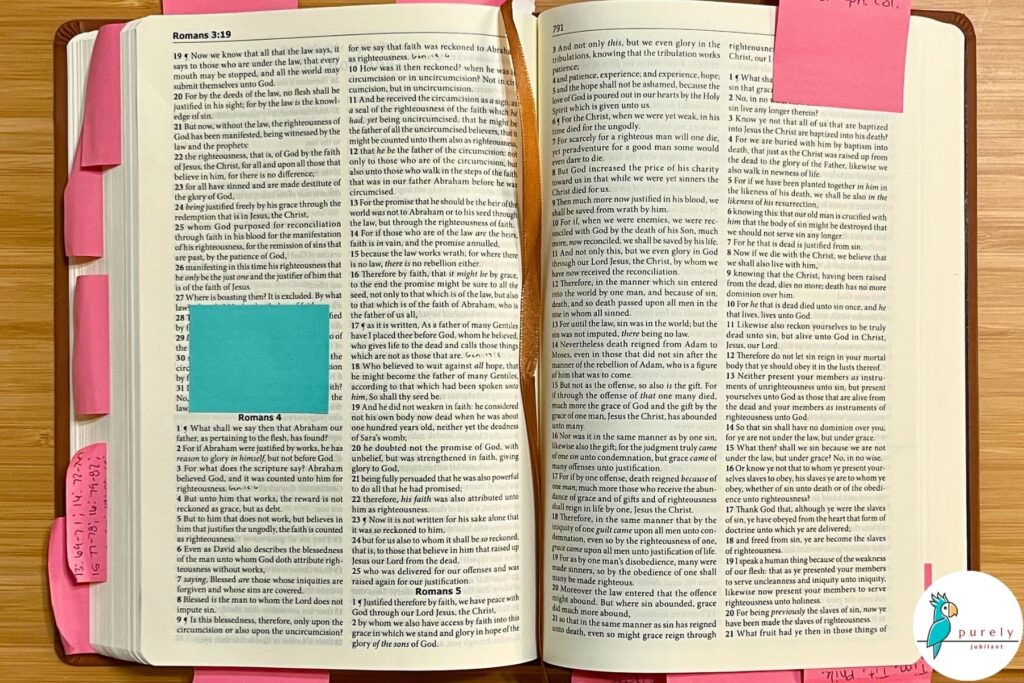
This Post-it method helps me keep everywhere I am reading while I move from one room to another. (I frequently have a Bible with me while out of the house as well.) But for those of you who have a permanent reading nook, you can either use real bookmarks or the free printable ones that I have attached with the printable reading plan at the end of this post.
After you print the reading plan, just fold it in half with the main reading plan on the outside and the Torah cycle on the inside and tuck it into your Bible.
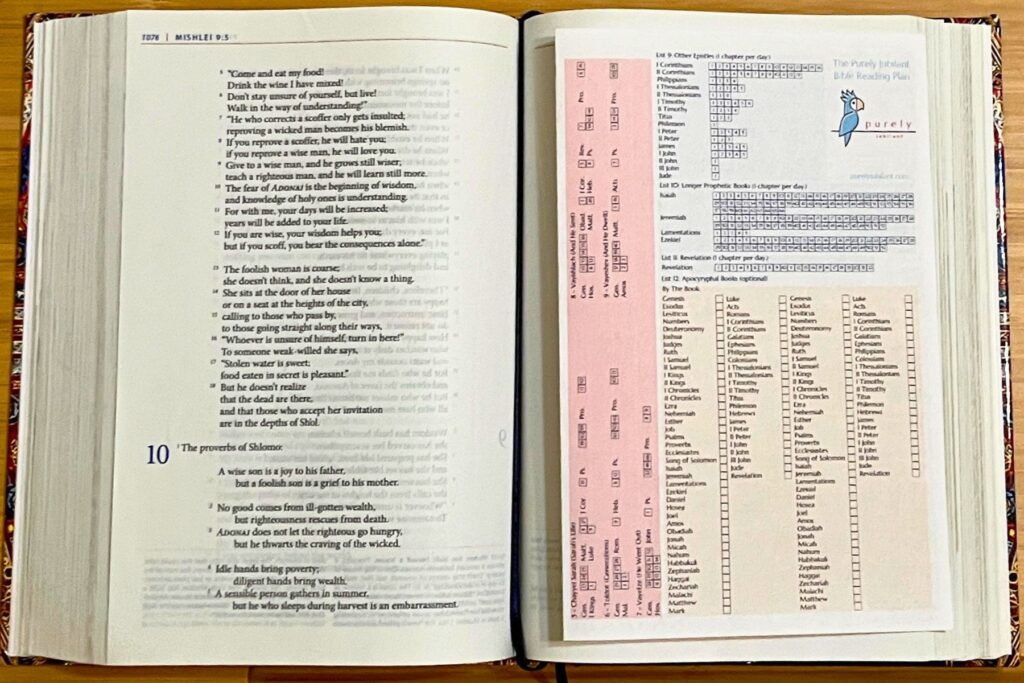
Then, you just mark off as you read.
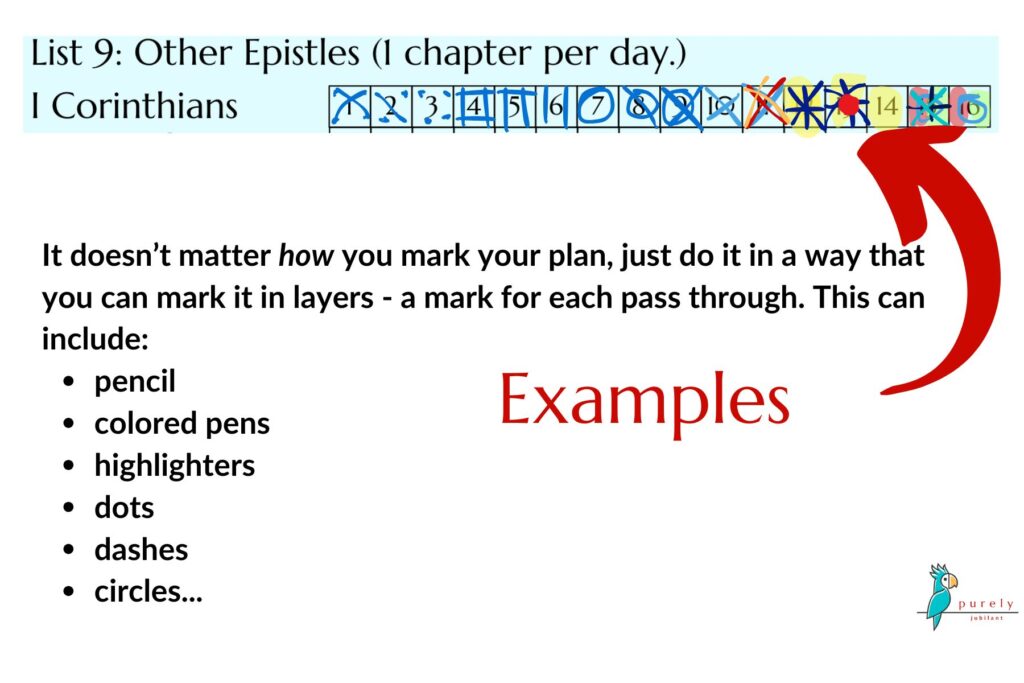
No matter where you are and how you mark it, choose an ambitious reading plan and challenge yourself to stick to it!
Purely Jubilant Dimensional Bible Reading Plan Part 1 Benefits:
The above reading plan will add a lot of breadth to your Bible study and although reading verses from all over the place may seem confusing or haphazard, you will begin to make connections that you never saw before. As Chuck Missler6 used to say, there is no page on baptism; the Bible is a hologram. When we begin to look at it from different places at once amazing things begin to show up!
Part 2:
My Other Two Bible Reading Plans
So, do I always read from 10/11 sections per day? No… I actually try to follow there above plan about five days per week, the other two days are much simpler, but not really any shorter.
By-The-Book Bible Reading Plan
On one-ish day per week, I like to read by the book, an idea that was ingrained into me by a pastor named David Pawson.7 So on this day I like to take a book, books, or part of a book and read straight through so that I get the whole thing in context.
Ideally this takes a day or maybe two or three for the longest books, but then I go back to the rest of my plan parts. If you need to spend more time here, that’s ok.
Torah Portion Bible Reading Plan
Finally, on Fridays or Saturdays, even though I ideally read a chapter of Torah daily, I like to read the weekly Torah Portions (actually their whole chapters), along with whole chapters of the haftarah and associated new covenant readings. I like to do this because it puts me in concert with Jews and Messianic Christians around the world and keeps me aware of God’s calendar.8
If you choose to read Torah portions and staying in sync with others matters to you, you will want to find an online calendar to follow along with as sometimes the weekly portions are doubled up (depending upon the year) and special portions are read on Holy Days. I suggest the Hebrew for Christians website and calendar as a good resource for this.
What About Bible Versions?
It has been said that the best Bible version is the one that you actually read. There is some truth in that, but it is also true that some versions are more accurate than others.
I tend to use a mix of translations and rotate through as I feel led or am in the mood for. My favorite way is to read multiple translation at once!9
Currently I read the KJV (also available for free online) or the Jubilee (also available for free online) bibles for my main five day per week reading plan. On my through-the-book plan days I like to read The Living Bible (available for free on Bible Gateway) or another easier to read version so that I can flow quickly through the book. On my Torah portion day I may use another version entirely, like The Complete Jewish Bible.
In particular I currently recommend the Geneva (free online) and The Jubilee. If you find these too antiquated to read comfortably/enjoy there is no shame! I adore the International Children’s Bible (ICB) and used it in much of my work. I also know an intelligent, educated adult who reads it exclusively. The ICB is so wonderful because it is not a storybook but an actual real Bible put together in simple (but not dumbed-down), easy-to-understand English. This particular ICB only says “Holy Bible” on the cover and is a neutral tan and brown color (the publisher must have caught on that adults are reading it too).
Purely Jubilant Dimensional Bible Reading Plan Summary
The Daily Breakdown:
- approximately 5 days per week I try to read my 11–12 section per day plan. I am currently reading this in The Jubilee Bible. This averages maybe 15 – 20 chapters per day
- approximately 1 day per week I try to read a book, books, or part of a large book (if I don’t finish it in one day, I finish it the next day(s) before moving on with my main reading plan). I am currently reading this in The Living Bible or The New Testament (translated by Richmond Lattimore).
- On Saturdays I like to follow a messianic Torah reading plan in which I read every chapter listed, not just the specific verses. I am currently reading this in The Complete Jewish Bible.
Flexible Bible Reading
This Bible Reading Plan has no dates and is 100% shame free. However you choose to add breadth to your Bible reading, don’t get discouraged! It’s ok to not get it done or miss a day or in some way fall short of what was planned. In fact, I’m pretty sure I’ve been off my plan more than on it, but I can confidently tell you that you can simply pick up where you left off and it will continue to be transformational in your life and in your understanding of Scripture.
Don’t Stop There
I suggest you use the above plan as a minimum. Keep a Bible by the table and choose a verse to think about or discuss while you eat.
Choose a different version or a commentary to keep by your bed for bedtime reading. l am currently enjoying The Rational Bible: Genesis.
Though it isn't in my current reading I also have and recommend Matthew Henry's Commentary on the Whole Bible.
Whatever you do, find ways to sneak the Bible into other parts of your daily life. It’s your bread, remember?
The Depth of Dimensional Bible Reading
Breadth/Broad-reading is great, but we also want depth. If study of the Scriptures is new to you, let me explain how we go deep:
Translations
The easiest way to begin to expand your knowledge of Scripture is to read various translations of the Bible because the different words used will start your mind meditating in the meaning.
Although it may seem counterintuitive, I would avoid translations with notes unless they are purely based on fact. For example, if a translation tells you that a certain kind of wood mentioned comes from a certain type of tree known for whatever characteristic and is usually used for such a product, that is a note based on fact. I personally find that notes explaining theology only take away from the Biblical text and of course reflect a personal point of view, which may or may not be accurate.
Some translations that I have enjoyed referencing over the years are:
- The Amplified (original preferred, both versions are available for free on Bible Gateway)
- The International Children’s Bible (available for free on Bible Gateway)
- The Expanded Bible (out of print, but available for free on Bible Gateway)
- The Names of God Bible (out of print, but available for free on Bible Gateway)
Languages
If you are bilingual:
First off, if you are bilingual (or trilingual or…) I encourage you to grab a Bible in the other language that you speak. Bilingual Bibles are great too. Personally, I read like to read in Spanish, but since my Spanish is not as strong as my English (yet!) I usually read an easier translation (La Nueva Traducción Viviente) as a stand alone and a more complex (La Reina Valera Gómez is what I have) in a bilingual Bible.
Bilingual Bibles
It is important, in my opinion, to have very similar readings in both languages when reading together, so I like the RVG with KJV because it is more similar than the traditional KJV/Reina Valera available on Amazon. The NTV and NLT are exact equivalent translations and I believe there are a few others available as well.
Side note: If you are looking for a Spanish translation, the Sagradas Escrituras (abbreviated SE and available for free on Blue Letter Bible) is my favorite and, in my opinion, the most accurate text available, which is why I am reading The Jubilee Bible in English (The Jubilee is closer to the Sagradas Escrituras than any other English Bible. You can see more about The Jubilee translation here). There is also a Jubilee Bible in Spanish and I would recommend it even though I personally have not read it yet.
The Benefit of Reading In Multiple Languages
Why does it matter if we read the translation in another language? Well, if you speak another language you know that words do not always have exact equivalents. In fact, English has a pretty small vocabulary compared to many other languages. If you are able to see a word in another translation, you will see that pretty regularly the word that you would have thought would be used based on the English rendering of the text is not actually the one used. This isn’t because the word was wrong, it is just that the other word is actually a different or closer translation to the original text. The ability to see them both (all) will add shades of meaning to the text and your understanding will begin to open as you see possibilities of meaning that were not apparent in English!
If you choose to bring in a Bible of another language, know that there is no right or wrong way to do it. You can incorporate as little or as much of it as you would like.
Original Language Study
Whether you are bilingual or not, one of the best ways to get at the root meaning of things in the Bible is to look at the original language in which it was written. Most of us don’t speak these ancient languages, so we will not be able to read through an original language fluently, but we can use tools like a concordance and a lexicon or the Blue Letter Bible website/app to get to the root word, all of its definitions, and all of its other uses in the Bible to see what it means. It can be pretty eye opening!
Here a few free, online ways to do this:
Studying By Word
You can go to http://strongsconcordance.org and look up a word. Here is “jubilee”:
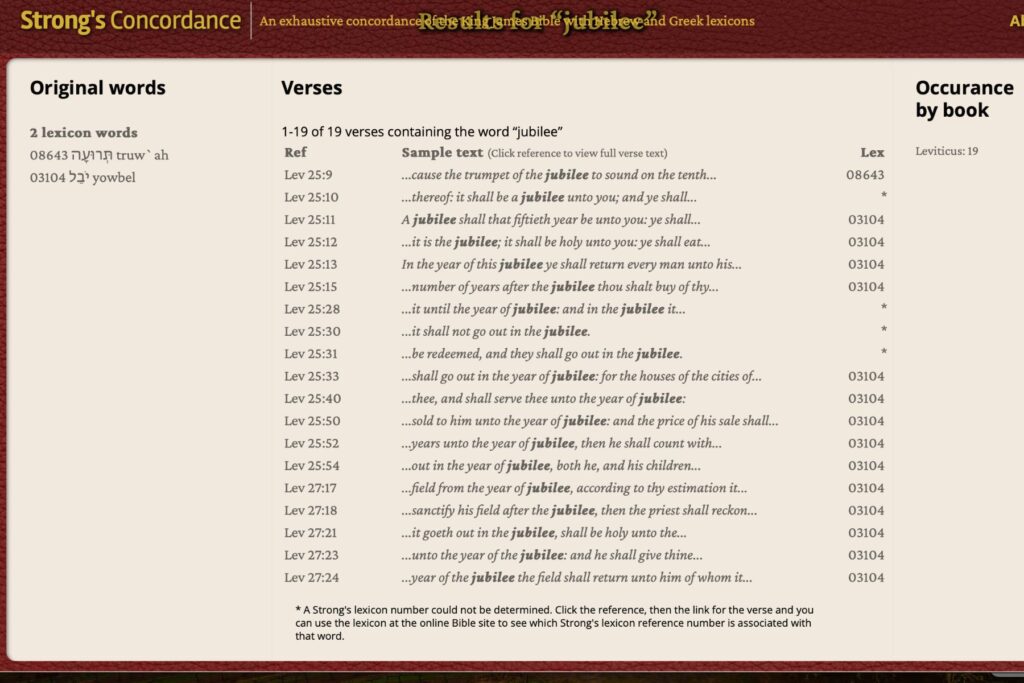
Then, you can click on the entry that interests you to see the definition:
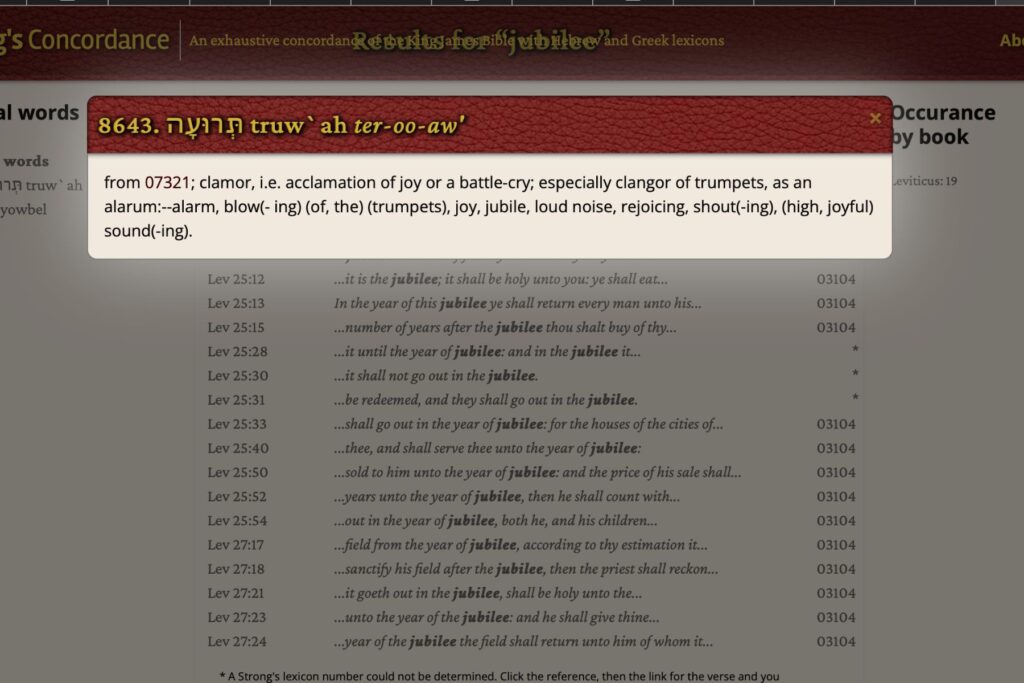
Or, you can search by verse.
Studying By Verse:
I like to do this at https://www.blueletterbible.org. Here we will look up a verse (Leviticus 25:9) that has “jubilee” in it:
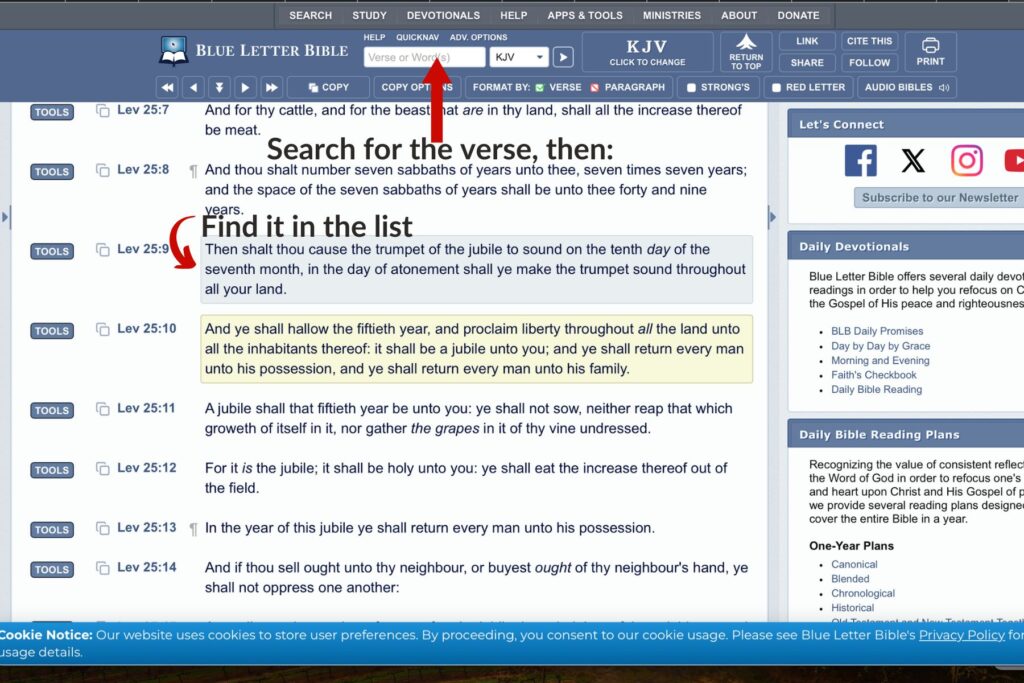
When you find the verse on the list click “tools” and then “interlinear.”
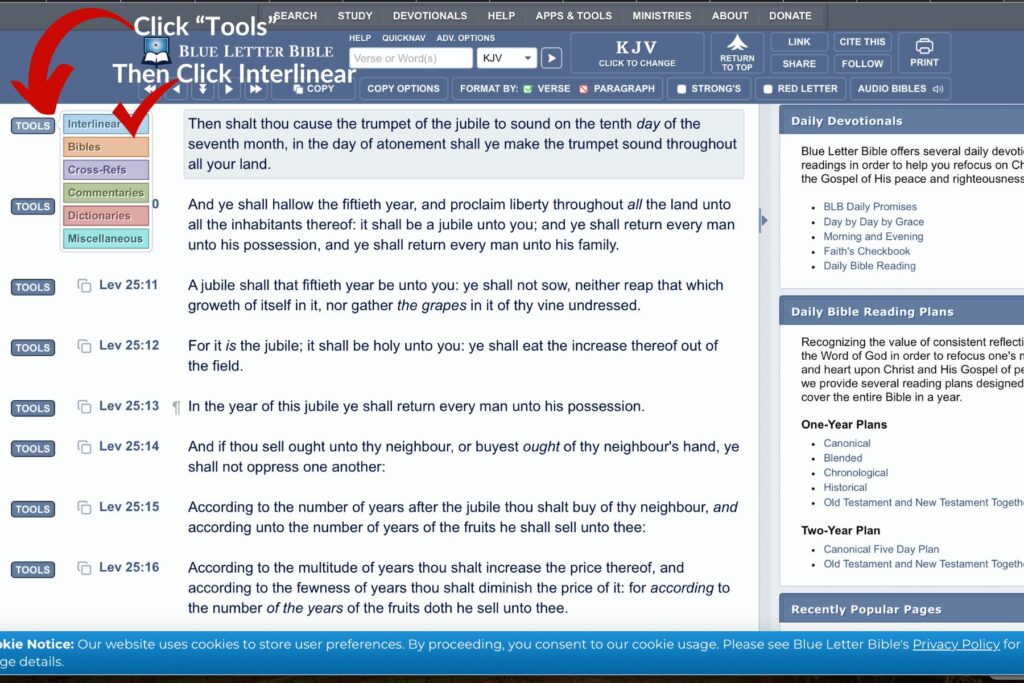
When the interlinear verser comes up, click on the number of the word that you want to research:
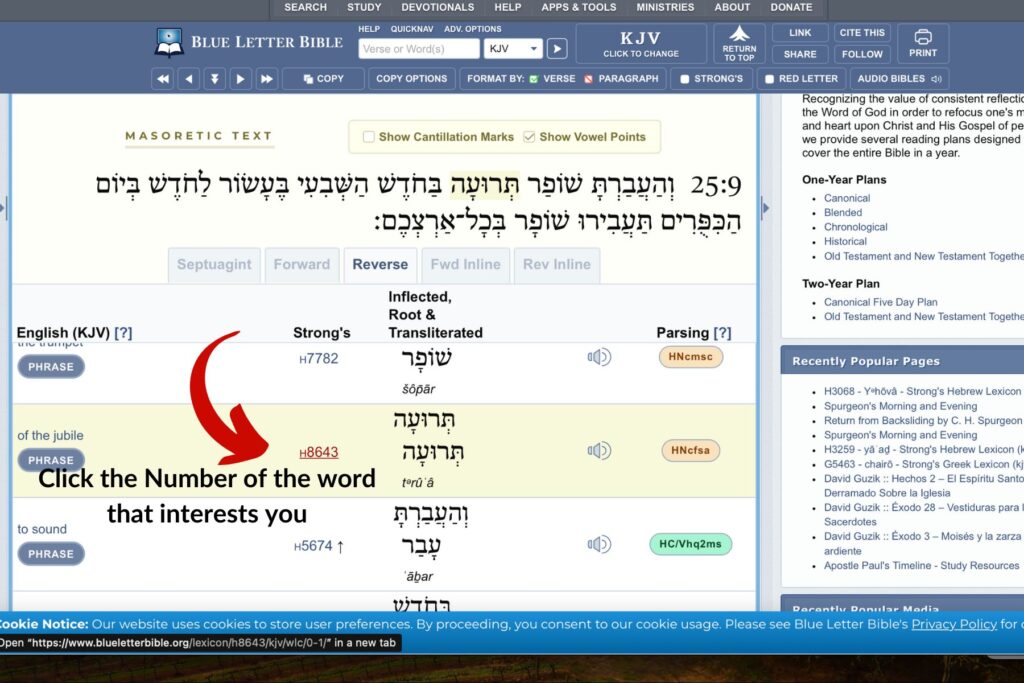
You will be able to see the original word:
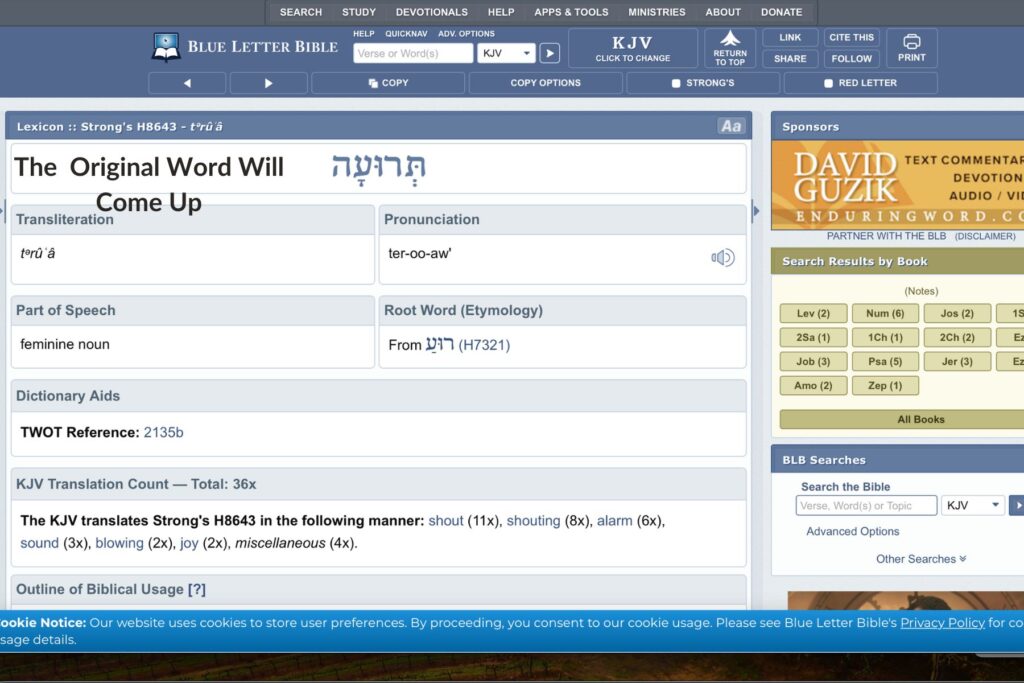
Then, you can scroll down and read about its historical usage.10
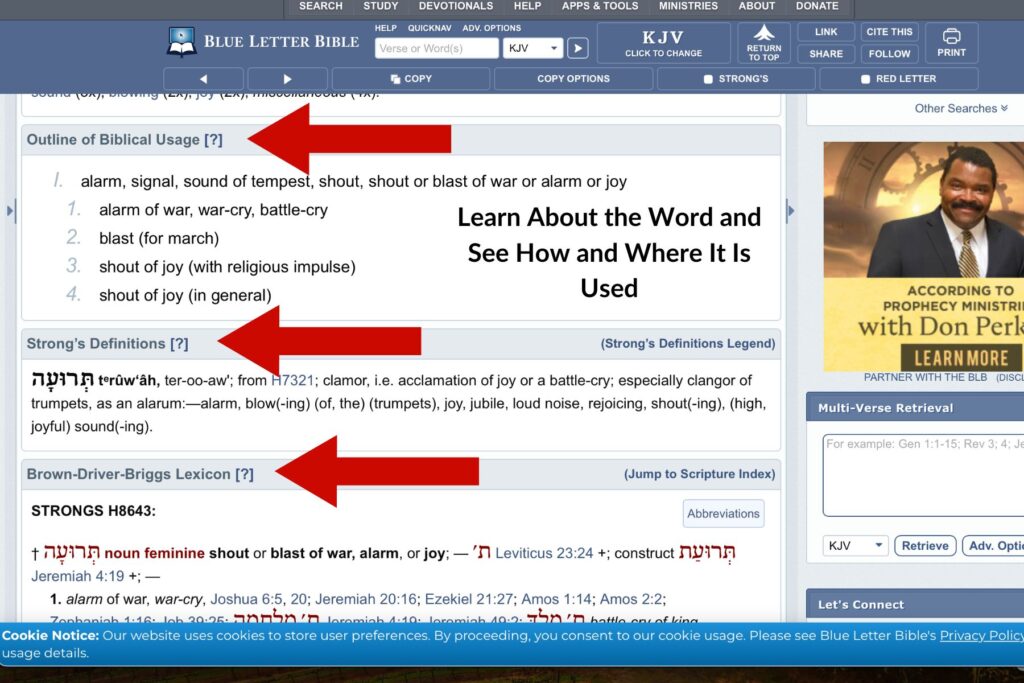
Offline Root Word Study:
You can also buy some printed books for home study if you like to do things low-tech. This is a basic set up to find the root word and then look it up:
- Strong’s Exhaustive Concordance
- Brown-Driver-Briggs Keyed Hebrew Lexicon (for the Old Testament)
- Thayer’s Keyed Greek Lexicon (for the New Testament)
Learn the Hebrew Alphabet
Studying the Scriptures becomes really fun when you learn (or just have a reference page!) on the Hebrew alphabet. The original Hebrew alphabet was totally unlike ours in that each individual letter carried a meaning (as opposed to just a sound). It is possible to look at Hebrew words, reference the letter meanings, and reconstruct the word from the original letter meanings. Why would you do this if you already know the meaning of the word in English? Because you might find completely profound!
Here is a jewel that I found:
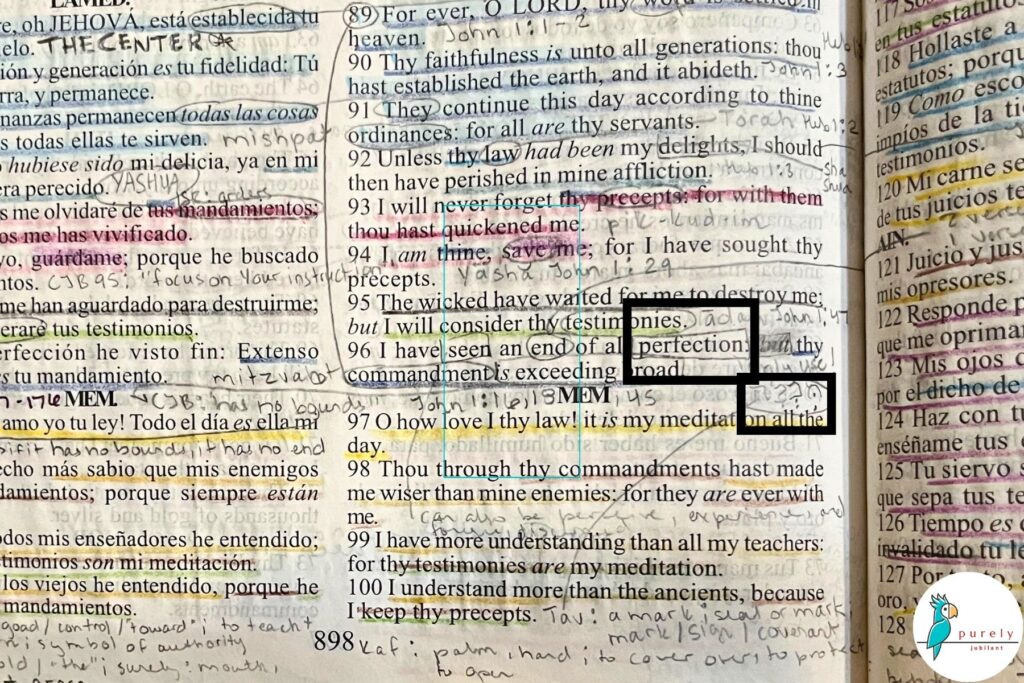
Look it up and see what you think it might mean!
Obviously, when doing this we can’t completely throw out the established meaning of words, but it can be a useful aid in making connections that bring understanding.
Look Up All Names
Names in the Bible usually aren’t translated; they are transliterated (meaning the name is written in such a way that it sounds the same or close to the same as the original name does). If you’ve ever looked at a baby name book, you know that names have meanings. The names in the Scriptures are very meaningful, like when God changes Abram and Sarai’s names or names Hosea’s children for him. If we do not see the meaning of the name in our English Bibles we are missing an obvious message in the text. For example: In Genesis 5 it is possible to find a prophecy of Jesus’ work on our behalf in a genealogy!
Don’t just look up people’s names… Look up every name. I suggest you start with Mount Ebal and Nazareth.
Know the Meaning of Each Number
Numbers in the Bible have meaning and are often symbolic rather than exact. Make a note of what each number means and keep it handy when reading. You will find at times that something was not immediately clear when you read it, but that you were able to understand it immediately when the meaning of the number was incorporated into your reading. Here is an interesting resource for learning more about numbers in Scripture.11
Recognize and Follow Quotations
Did you know that the New Testament contains close to 900 quotations of/allusions to the Old Testament? The writers of the New Testament expected the readers to be familiar with The Scriptures (which at that time was only the Old Testament!). Every time there is a quote or illusion you are intended to know not just the verse being quoted but also the context of the passage so that you understand the ramifications of what is being said.
Don’t be overwhelmed by this, just start to locate and read the quotations/allusions. Some Bible translations demarcate these, but others don’t. (The Complete Jewish Bible is very good at this, but I don’t totally agree with their theology, so please exercise caution if you are unsure what you believe and why.)
If your Bible doesn’t tell you which verses are quotes or allusions, don’t worry – just look them up. Here is a good resource for that that is free online. You will also begin to find them naturally if you follow the Purely Jubilant Dimensional Bible Reading Plan.
Try to Find the Main Idea of each Passage
Many parts of the Bible have a chiastic structure, that is, they are sort of like rungs on a ladder with the the top of the ladder being the apex, or main point. Imagine something like this:

Now, if you saw something sitting on top of that ladder it would be pretty obvious what the focal point was. The only problem is that if your Bible is printed in paragraphs you are likely to see this:
Some things. Some things. Some things. The first thing. The second thing. The third thing. The most important thing. The third thing. The second thing. The first thing. Other things. Other things. Other things.
Or, if your Bible is printed verse by verse:
Some things.
Some things.
Some things.
The first thing.
The second thing.
The third thing.
The most important thing.
The third thing.
The second thing.
The first thing.
Other things.
Other things.
Other things.
In other words, in a sea of ‘things’ we really have to pay attention to find what are, essentially, arrows or landing strips screaming, “Pay Attention!” If reproduced visually, these sections would look like the ladder in the photo above or something like the following:
Some things.
Some things.
Some things.
_______First thing.
______________Second thing.
_____________________Third thing.
____________________________The most important thing.
_____________________Third thing.
______________Second thing.
_______First thing.
Other things.
Other things.
Other things.
What stands out to you as the apex? (Answer: The most important thing.)
Finding Chiasms
Chiasms can be found throughout Scripture and are awaiting your discovery. Sometimes they are very small with only two ideas that don’t have a center point like:
The Sabbath
_______was made for man
_______not man
For the Sabbath12
But they can also be very large… even as large as the whole Bible.
Usually, however, you will be most likely to notice the chasms that are within a chapter (like this one from Joshua 1) because as you are reding you will think to yourself, “Hey! I just read that!”
Teasing Out Chiams
When you have a “I just read that!” moment:
- flip back to the first place that you read the phrase and see what it says next (the second thing).
- When you have the second thing in mind, go back to where you first thought, “Hey! I just read that!” and look at what is written just before that.
- Is the same word (man, listen, law, etc.) or same idea (pay attention, be obedient, etc.) repeated in these two areas?
- If you find that the two similar ideas are in both sections, you will likely be able to keep making matches all the way back to a center point that stands alone as the focal point.13
When looking for chiasms, please remember that the Bible was not written with chapter and verse – they were added later. Don’t limit yourself to the idea that there needs to be a specific idea in each individual verse; there may be more than one idea per verse or the idea may take up more than a single verse. If it helps you, write the ideas in the arrow format above to help you sort through them.
Look Out For Jesus in the Old Testament
Did you know that Jesus actually appears many times in the Old Testament? He does! See if you can find Him! Here’s a hint: “The angel of the Lord” isn’t always the winged creature that you may imagine.
“Angel” actually means “messenger.”
Also keep a look out for “The Lord of Hosts.” Who do you think that might be? 😉
Wrestle with the Information
Finally, to dig deep in our Bibles we can rewrite them. I don’t mean copying them word-for-word (though I know someone whose life was transformed by doing that) and I don’t mean actually changing the Bible (we are issued a grave warning against adding to or taking away from Scripture!)14. What I mean is to rewrite each verse into a sentence and make paragraphs with the sentences. Again, do not copy the actual Scriptures, but use your own words. Forcing your mind to synthesize the material will make you wrestle with – and understand- it in a way that you never have.
The Height of Dimensional Bible Reading
How do add the dimension of height to our Bible study? Well, mountains are formed by layers so you start adding layers. Layers of notes, layers of tabs, layers of colors, even layers of pages.
Layers of Notes
Yes, your Bible is the inspired Word of God, but please don’t treat it like a museum exhibit; have a relationship with it! If you follow my reading plan, you will find verses that relate to each other throughout the Bible, note them in each section so that when you flip through there you are linked to the other one.
Connected Ideas
You will find connected ideas across paragraphs and pages. Link them together with lines or arrows.
Chiasms
When you find a chism, mark the beginning, center, and end.
Personal Revelation
When the Holy Spirit shows you a deeper meaning, write it in the margin.
Personal Application
If the Holy Spirit shows you how something applies in your life, write it down with any relevant information and add the date.
Questions
If you don’t understand something, add a question mark and pray about it. Someday you will read it again and know what it means. When that happens, add the date and thank God for answering your prayer. You can even write in the meaning that you now understand, if you like.
Translation Differences
If you use a bilingual Bible, you can note where vocabulary is different or even conflicting.
Divine Names
Look up and write in the names of God that are usually not translated in to English. The easiest way to do this is to look up the verse/chapter in the Names of God Bible on Bible Gateway.
If… Then
You can even note cause and effect. There is no limit, just start interacting with your text. It is too easy for people to think of something profound or discover something new and subsequently forget about it.
Your Journey
Writing notes is also a history of your journey with God. You will someday be able to look at that page and think, “I remember when I struggled with that,” or, “I remember when I used to think like that.”
Tools
I’ve used many different types of pens and pencils to make notes and I wish that I had begun with ink. My pencil notes in many places have rubbed off to the point of being difficult or impossible to read. Most pens bleed through to some extent, the smaller the tip the better for both preventing bleed through and conserving space. I eventually settled on these Pigma microns which get the job done, but I wouldn’t be surprised if there is something better out there; I would have a look around and be sure to test whatever you find before using it in your Bible.
Layers of Tabs
Add tabs everywhere you need them. Sure, you can add named book tabs to help you locate books quickly, but put a tab on prayers that you find that you want to pray frequently. Put a tab on topics that you feel need to be able to share with others. Put tabs anywhere that you want to be able to find quickly and easily. Then, use them!
Layers of Colors
My mentor and friend suggested that I color code my Bible as she does. I ended up doing it very differently than she does, but it was a suggestion that changed my life and I suggest that you try it. I’m honestly not sure if she told me how she does it, but I’ve seen her Bible and can see that it is different (far less colorful) than mine. I tell you that so you feel free to look up how other people do it so you can get an idea of how you can do it in a way that suits you.
Adding Color by Topic
My Bible currently has colors for:
- God the Father
- God the Son/The Messiah
- The Holy Spirit
- Who we are in Christ
- Biblical prayers and blessings
- Scripture to pray
- Blessing/worshipping God
- The Father’s Words
- Jesus’s Words
- The Holy Spirit’s Words
- sin/the devil/evil/kingdom of darkness/consequences
- If… (one color) then (another color) = conditional promises
- Directions to us
- Quotes of the Old Testament in the New Testament
- Prophecy and declarations
- Fulfilled prophecy
- Spiritual principles
- Law
- Faith
You can do all or none of these or even things that are completely different.
If you choose to use my list of color topics, please know that you may find it difficult to determine which member of The Godhead is speaking/present/being referenced. They are truly echad15 - I haven’t aways been able to tease out the differences.
The Results of Color Coding
I can tell you that the result of color coding my Bible has been nothing short of amazing. One can actually SEE the story unfolding or the emotion behind the psalm. It is amazing/horrifying to look at Kings and see something like ——— (but he did not tear down the high places) ——— but he did not tear down the high places) repeated in color throughout the book.
Tools For Color Coding
When I first started with color coding, I used these erasable colored pencils. They work very well for being able to correct mistakes, but they made my Bible pages rumply. Now, I just use Prismacolors and live with the mistakes. In other areas I also made use of erasable highlighters, but for extra emphasis I have used mild liners, which do bleed through some of my Bibles. You can probably find something better than what I have; just make sure you test whatever you end up with before you use it!
Tip: Make a color key on one of the front pages of your Bible so that anyone in the future will know what each color means. What an heirloom!
Layers of Pages
You can also add layers of pages to your Bible. Again, I don’t mean adding to the Word of God. I am referring to adding pages of information, study notes, word definitions, and even commentary:
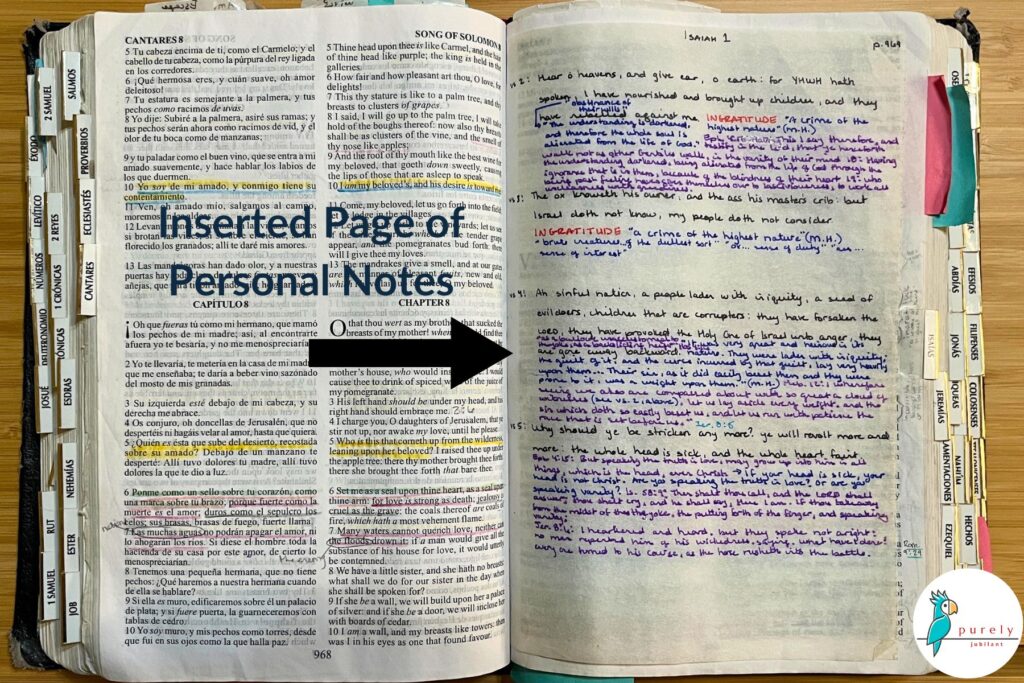
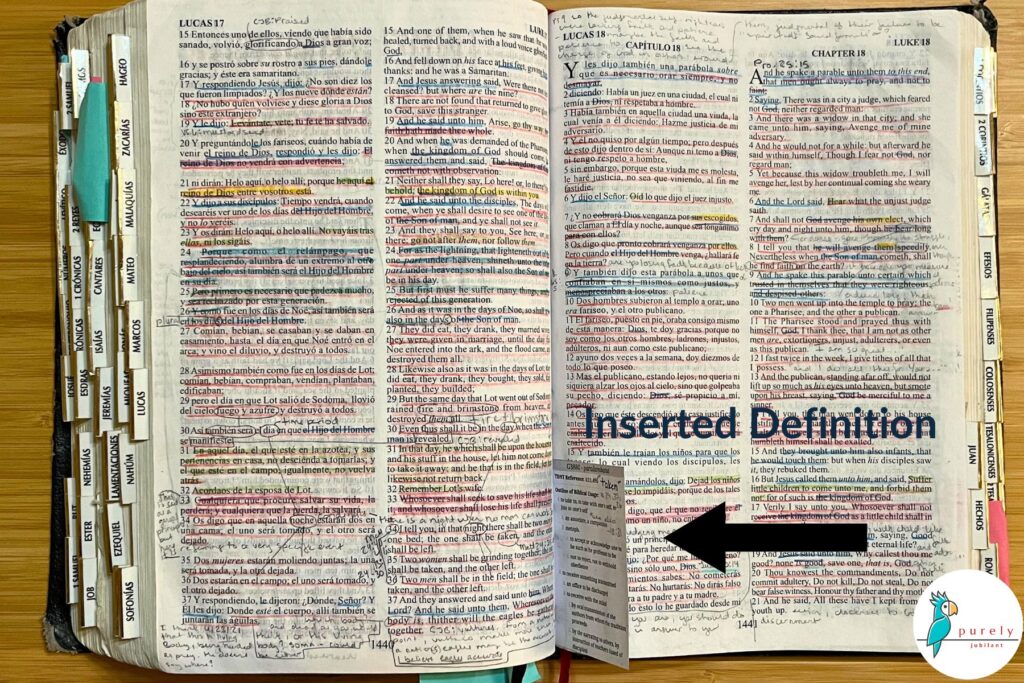
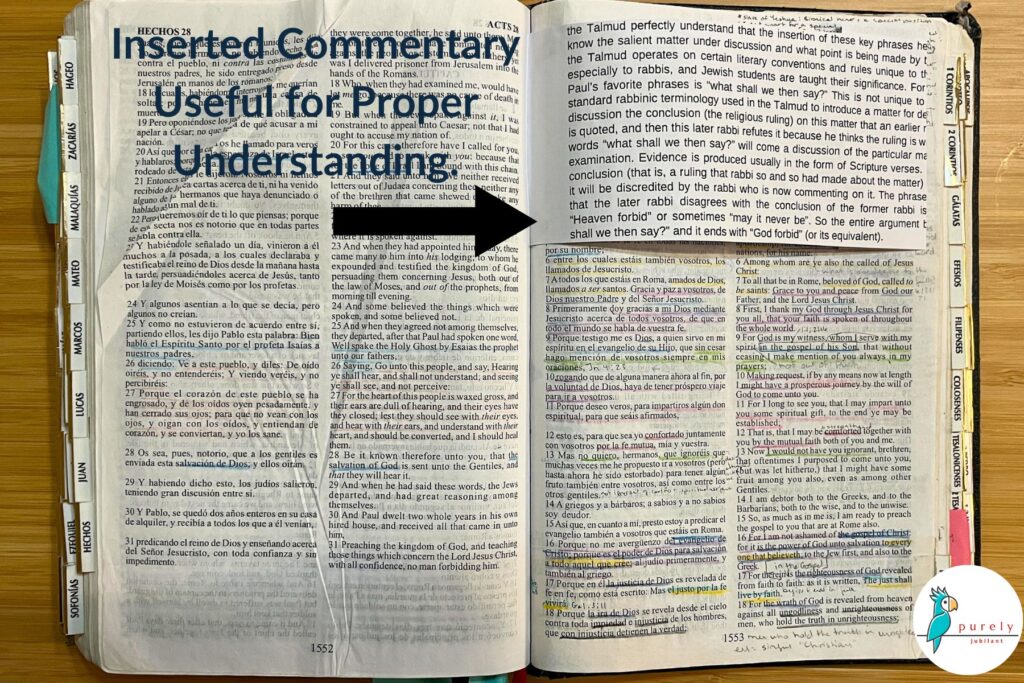
I added so many pages to my Bibles that it eventually broke the bindings. (If you have a glued and not Smyth sewn binding it is likely to break with heavy use anyway.) I have found that Elmer’s Craft Bond works well and holds together for years; I’ve never had to have professional repairs.
You can also insert pages in the front and back of the Bible to add reference lists, a personalized index, things to remember, and more.
How to Add Pages:
To add small “pages” of notes, you can just use sticky notes. To add full pages: take a sheet of acid-free tracing paper and fold it in half from top to bottom. Then, fold the folded edge about 1/4” down. Place three acid-free removable glue dots on the outside of the small, folded flap, open your Bible wide, and nestle the folded edge into the crease between the pages. Lay the paper down over the fold and run your finger along it to adhere the glue dots. Now, you should have two loose pages that are blank on the front and the back that turn easily, just like the pages of your Bible.
The Width of Dimensional Bible Reading
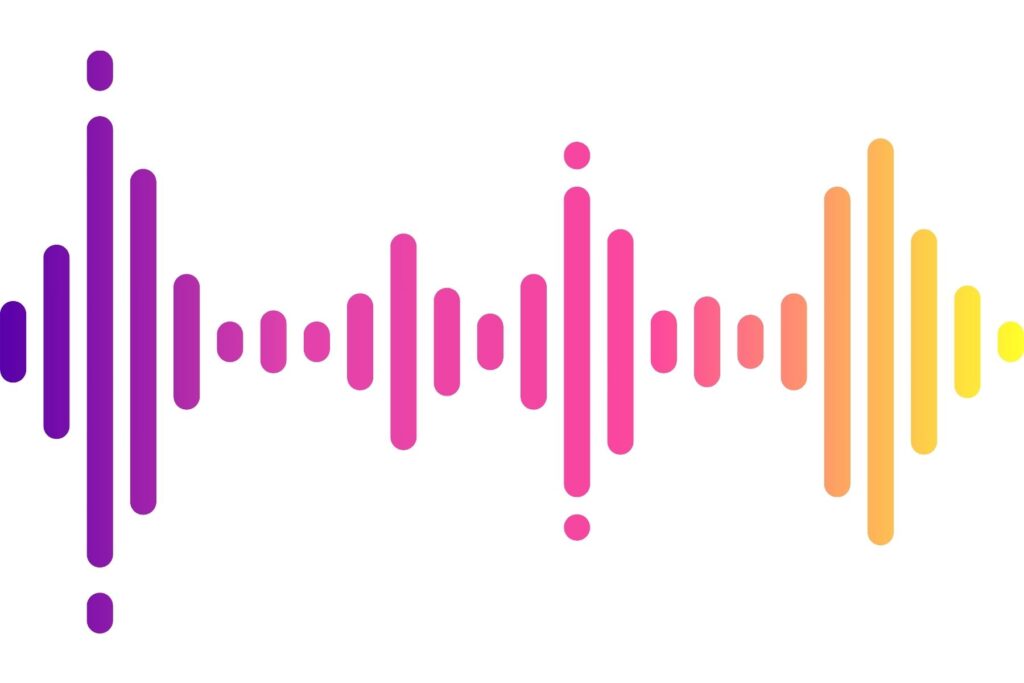
The fourth dimension that I encourage you to add to your Bible study is sound. Particularly I mean singing Scripture, but we will also cover audiobooks and music.
Biblical Meditation
Do you know what the word “meditate” means in the Bible? Perhaps it conjures up images of a swami or buddhist gongs… Let me assure you, I am not referring to anything “new age”! ‘Meditate’ in the Bible means ‘to mutter.’
The Power of God’s Word
The spoken word has POWER. Thinks about these verses:
- And God said, Let there be light: and there was light.16
- Death and life are in the power of the tongue: and they that love it shall eat the fruit thereof.17
- Pleasant words are as an honeycomb, sweet to the soul, and health to the bones.18
- The Lord GOD hath given me the tongue of the learned, that I should know how to speak a word in season to him that is weary: he wakeneth morning by morning, he wakeneth mine ear to hear as the learned.19
- A word fitly spoken is like apples of gold in pictures of silver.20
- Then the LORD put forth his hand, and touched my mouth. And the LORD said unto me, Behold, I have put my words in thy mouth.21
- For the word of God is quick, and powerful, and sharper than any twoedged sword, piercing even to the dividing asunder of soul and spirit, and of the joints and marrow, and is a discerner of the thoughts and intents of the heart.22
- And take the helmet of salvation, and the sword of the Spirit, which is the word of God:23
- And he had in his right hand seven stars: and out of his mouth went a sharp twoedged sword: and his countenance was as the sun shineth in his strength.24
From the above we can learn:
- when God speaks His Word accomplishes things.
- God didn’t want His prophet to speak mere human’s words but His (God’s) own
- knowing the right thing to say and the right time to say it is important
- pleasant words can be healing
- God’s Word is a sword that we are supposed to use.
Putting It Into Practice
That’s all pretty basic stuff that you probably know. But, here’s the thing: babies learn to speak by practicing and swordsmen learn to fight by practicing. So, we can probably learn by… practicing. Speak His words aloud over your situation. Let The word heal you, convict you, and teach you. Say it so often that it is what rolls off of your tongue without having to think about it. Then, when you need to pray, the Scripture will pour forth out of you. You won’t need to wonder what to pray and you won’t need to know what God’s will is because it will already be in your mouth!
You can practice speaking God’s Word by reading aloud, or you can practice by picking a verse or section and muttering it to yourself while driving, cleaning, combing your hair, etc. When I am particularly moved by a section of the Bible I will read or reread it aloud, often as a prayer or proclamation of worship/praise. My favorite way to practice isn’t to speak it though… I have found that I remember the most when I sing so I sing it!
Singing Scripture
There are a few ways you can sing Scripture. The simplest way is just to open up your Bible, find a section and sing it, making up the tune as you go. For a real deep dive into it, you can do as Julie True suggests and sing it twice more, once as you personalizing it to God and once as if He is singing it to you. I’ve done it and it was interesting to say the least. I suggest you start with something like Psalm 91 if you want to try this.
Scripture Songs
For me personally, Scripture songs are THE BEST. Period. There are many, many Scripture songs out there, but I prefer the ones that cover an entire chapter because it makes it so easy to memorize. (I dare you to try it if you don’t believe me!)
Here are a few of my favorites:
How To Use Scripture Songs
Here is the key to singing these songs: don’t stop. Don’t take a one-and-done approach. I used to walk about an hour and a half per day and for days at a time I broke my walk up into chunks and listened to/sang the same song on repeat with a chapter (usually about 10 minutes each) on repeat. The last sing that I did this with was Isaiah 53 and I don’t know how many times I listened to it or how many people heard me singing it, but eventually I began to receive revelations on what it really means in a way that I could never have been taught by a (human) teacher.
So, don’t be in a hurry to memorize a bunch of songs; stay with a song until you really have an experience and know that Scripture like the back of your hand. You will be amazed at how The Holy Spirit will whip it out of your back pocket and put it in your mind and in your mouth just when you need it!
Audio Bibles
I don’t recommend audio Bibles as replacement for your personal reading time, but they can be useful to listen to as you do chores or at other times that you wouldn’t normally be reading. Sometimes hearing the emphasis of a sentence put somewhere different than where you put it is eye opening. I have found this version to be particularly attention-keeping.
You don’t need a fancy or professional (expensive) version of an audio Bible though. One time I was listening to a free app version of the book of Daniel as I fell asleep and The Holy Spirit taught me something that I had never heard before, but which was later confirmed to me through a few other people that I trust.
So, go ahead and give audio Bibles a shot while you are cleaning or driving, but they should be an addition to your reading time and not a replacement of it
Music Made From Scripture
Just as an interesting tidbit for you, there is now music available that is made from the Psalms by turning the letters into a musical scale. Although there are other artists offering music found in the Scriptures, I own a Steve Rees album and have also listened (a lot!) to his generous YouTube channel. Although I do enjoy reading, worshipping, praying, and even sleeping with this music, it is, obviously, not a replacement for actually reading the Bible. Instead, it might be something that you enjoy listening to as you read.
Invitation
Well, what do you think? Does it seem like a lot? Too much? Do you remember the portion of Scripture that we opened with? Here it is again:
And Jacob was left alone; and there wrestled a man with him until the breaking of the day.
Genesis 32:24-30
And when he saw that he prevailed not against him, he touched the hollow of his thigh; and the hollow of Jacob’s thigh was out of joint, as he wrestled with him.
And he said, Let me go, for the day breaketh. And he said, I will not let thee go, except thou bless me.
And he said unto him, What is thy name? And he said, Jacob.
And he said, Thy name shall be called no more Jacob, but Israel: for as a prince hast thou power with God and with men, and hast prevailed.
And Jacob asked him, and said, Tell me, I pray thee, thy name. And he said, Wherefore is it that thou dost ask after my name? And he blessed him there.
And Jacob called the name of the place Peniel: for I have seen God face to face.
Personal Application
The first time we read this passage we discussed how we can see God’s face through seeing Him in His Word. But, here’s the key: Jacob had to wrestle to do it. It lasted all night. On the ground. In the dirt. Surely, there were tears. Maybe there was blood. Certainly, he was sore, he was tired, he had plenty of other things to do (like find his wives and children that he had sent ahead), but He refused to let go of God until he knew Him (saw His face).
Have You Had A Moment Like Jacob’s?
Have you “seen God’s face”? Do you know Him that intimately? Everything that we do with God or for God ought to be rooted in love, but how can you love Him if you don’t know Him? How can you know Him if you don’t spend time with Him? Seek His Face!
Know God
It’s time to know God. It’s time to rise up! I invite you to strengthen your spiritual life by wrestling with The Word. We must know God. Again I tell you, seek His Face!
Search Him Out
“It is the glory of God to conceal a thing: but the honour of kings is to search out a matter.”25
Seek Him out! In our busy world lavishing time and attention on God makes about as much sense as wrestling in the dirt through the night. But, it’s worth it. He’s worth it.
So, will you join me?
If you are willing to take up the challenge and add one, two, three, or even four extra dimensions to your Bible study, I congratulate you!
FREE Purely Jubilant Dimensional Bible Reading Printables!
If you want to use all or part of my reading plans, I have created a free printable for you to use (below). There are absolutely no strings attached to this download. You don’t have to sign up for any lists or give me your email address; I just want you to experience a deeper walk with God.
FREE Printable Daily Reading Tracker
This is the main Bible reading tracker. There is a color-coded section for each of the 3 Purely Jubilant Dimensional Bible Reading Plans:
- Blue for the main 5 days per week plan
- The Psalm chapters are in color coded blocks so that you can finish them in a month, if desired, by reading through one blue or yellow section daily.
- Yellow for the by-the-book days
- Red for the Torah Portions
The following PDF intentionally has the second page upside down so that it can be easily printed two-sided.
FREE Printable Bookmarks
There are 14 Bookmarks: 12 for the main plan and one each for the Torah Portions and By The Book days.
FREE Printable Reading Tracker
This tracker is where you can note all of the books completed as you restart sections of The Purely Jubilant Dimensional Bible Reading Plan.
Share the Good News
After you implement any/all of these dimensional Bible study ideas, please come back and tell others how it has changed your life. Your stories give hope to those who need it.
Stay Connected
Would you like to stay connected? I have been too busy to post content regularly, so if you would like to be notified of new content in the future please get on my notification list.
A Podcast Is Coming!
Would you like to hear the Bible daily? Let’s create a Dimensional Bible Reading Community. We will let you know when it is ready to launch.
Do You Want to Contribute?
Did you find this helpful? Would you like to support Purely Jubilant’s work? You can contribute here, if you like.
Share Your Thoughts
Do you have anything good, worthy of praise, honorable, beautiful, and/or respectful that you would like to share? Please chime in and tell us in the comments below.
We are here for you!
Be well,
Your Friends at Purely Jubilant
Would you like to Learn More?
Read a related post:
Would you like some personal help?
You can:
Resources for this post:
- This verse actually refers to something closer to the spoken word, but the written words were received in that manner. ↩︎
- https://www.blueletterbible.org/lexicon/g4487/kjv/tr/0-1/ ↩︎
- If you are new to all this spiritual stuff, don’t worry, no one is going to force you to give away your money, so please don’t let that scare you. ↩︎
- Side note: the domain ‘Tithe Your Time’ was stolen from me. Rats! ↩︎
- As far as I know, there is no official website for this, an internet search will give you many options to learn more. ↩︎
- https://www.youtube.com/@koinoniahouse ↩︎
- https://www.youtube.com/@DavidPawsonMinistry ↩︎
- You might be wondering why this matters… My thinking is that if God makes a date to “show up” for a special event I want to be there! ↩︎
- The CJB contains notes and, if you choose to read this version I ask you to note that I do not agree with all of the theology presented. If you are a new believer maybe don’t start with the CJB until you are clear on what you believe. ↩︎
- This method isn’t perfect. The word porneia in particular is problematic… but it is a good starting point. ↩︎
- I do not personally know the person/people behind this ministry. I have enjoyed many of their posts, but I do not see a statement of faith and do not know exactly what they believe. Always pray about what you read on the internet and ask that God will show you His truth and prevent you from being led into error (even here on purelyjubilant.com!). ↩︎
- Mark 2:27 ↩︎
- It is a good practice to actually look the other direction as well in case the chiasm actually started early than you noticed. ↩︎
- Deuteronomy 4:2; Revelation 22:18-19 ↩︎
- https://biblehub.com/hebrew/259.htm ↩︎
- Genesis 1:3 ↩︎
- Proverbs 18:21 ↩︎
- Proverbs 16:24 ↩︎
- Isaiah 50:4 ↩︎
- Proverbs 25:11 ↩︎
- Jeremiah 1:9 ↩︎
- Hebrews 4:12 ↩︎
- Ephesians 6:17 ↩︎
- Revelation 1:16 ↩︎
- Proverbs 25:2 ↩︎
Disclosures, Disclaimers, Terms & Conditions:
Purely Jubilant is an Amazon affiliate and uses Amazon and other affiliate links to recommend products that we use and approve of. That means that as an Amazon associate I may earn a commission from qualifying purchases. Using an affiliate link does not change or increase your price in any way, it, in essence, gives us a small amount of money (often cents) that we use to keep this site ad free and easy for you to read.
Purely Jubilant is not a licensed medical provider and cannot offer medical advice. We do not diagnose or treat and do not suggest that leave the care of your qualified health care provider. You are advised to consult a licensed health/mental health professional before acting on any of our advice.
You use this website and its information as well as all linked websites and products at your own risk. We are not liable for any adverse outcomes.
Please learn more by clicking the links in our footer below.

